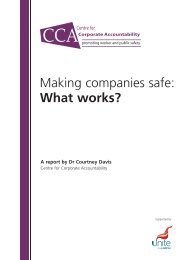Manual Handling Manual Handling Operations Regulations 1992 ...
Manual Handling Manual Handling Operations Regulations 1992 ...
Manual Handling Manual Handling Operations Regulations 1992 ...
You also want an ePaper? Increase the reach of your titles
YUMPU automatically turns print PDFs into web optimized ePapers that Google loves.
Health and Safety<br />
Executive<br />
Guidance<br />
49 An assessment made at the last minute is unlikely to be ‘suitable and<br />
sufficient’. In carrying out assessments, employers, in consultation with their<br />
employees, need to use their experiences of the type of work being done. This<br />
approach will help particularly with the assessment of work which:<br />
(a)<br />
(b)<br />
(c)<br />
is very varied (such as construction or maintenance); or<br />
is peripatetic (ie takes place at more than one location, for example, making<br />
deliveries); or<br />
involves dealing with emergencies (such as fire-fighting, rescue and medical<br />
emergencies).<br />
50 In the case of delivery operations, for example, a useful technique is to list the<br />
various types of task, load and working environment concerned and then to review<br />
a selection of them. This can be done by starting at the beginning of the operation<br />
and working through step by step to the end point. The aim is to identify the range<br />
of manual handling risks to which employees are exposed and then to decide on<br />
any necessary preventive steps such as the use of handling aids.<br />
51 A distinction should be made between the employer’s assessment required by<br />
regulation 4(1)(b)(i) and the everyday judgements which supervisors and others will<br />
have to make in dealing with manual handling operations. The assessment should<br />
identify in broad terms the foreseeable problems likely to arise during the operations<br />
and the measures needed to deal with them. These measures should include the<br />
provision of training to enable supervisors and employees to cope effectively with<br />
the operations they are likely to undertake.<br />
52 This distinction is perhaps most clearly seen in the case of emergency<br />
work. Here it will be essential to provide training to enable staff to carry out risk<br />
assessments which allow them to make the rapid judgements that will inevitably<br />
be necessary in dealing satisfactorily with an emergency incident or in supervising<br />
realistic training (dynamic risk assessment). The assessment may change rapidly as<br />
the emergency progresses. Clear communication between parties is vital in such<br />
situations.<br />
53 In other areas, for example moving and handling people, a multi-staged<br />
risk assessment system may be applicable. A generic or task-based assessment<br />
should be undertaken to ensure that a unit, for example, is properly designed<br />
and equipped. Staff should be properly trained to meet the mobility needs of the<br />
expected patient/client group as safely as possible for all parties. In addition, an<br />
individual patient assessment will be required for those patients with significant<br />
mobility needs. Such an assessment is likely to change as the condition of the<br />
person alters and in line with decisions about therapies they may be undergoing,<br />
for example positioning for radiological examination. The assessment should<br />
identify what tasks will be necessary, who should carry them out and how that<br />
patient will be moved and handled. Ideally, the assessment should include specific<br />
information about ways the person may be able to assist with the manoeuvre<br />
themselves and also any handling equipment, for example hoists, slings or small<br />
aids to be used.<br />
4(1)(b)(i)<br />
54 Risk assessment for moving/handling people is a complex task requiring<br />
consideration of the medical condition of the patient and the human rights of those<br />
involved. This guidance is not intended to provide comprehensive advice on these<br />
other issues. Further information is contained in HSG225 <strong>Handling</strong> home care. 11<br />
Ideally this assessment should be carried out before admission to ensure suitable<br />
equipment is available on the admitting unit. Staff must be trained to recognise<br />
what they can and cannot handle safely in each unit. Information must be available<br />
to the staff carrying out the assessment about what equipment is available and<br />
how to access it.<br />
<strong>Manual</strong> handling Page 16 of 90
















